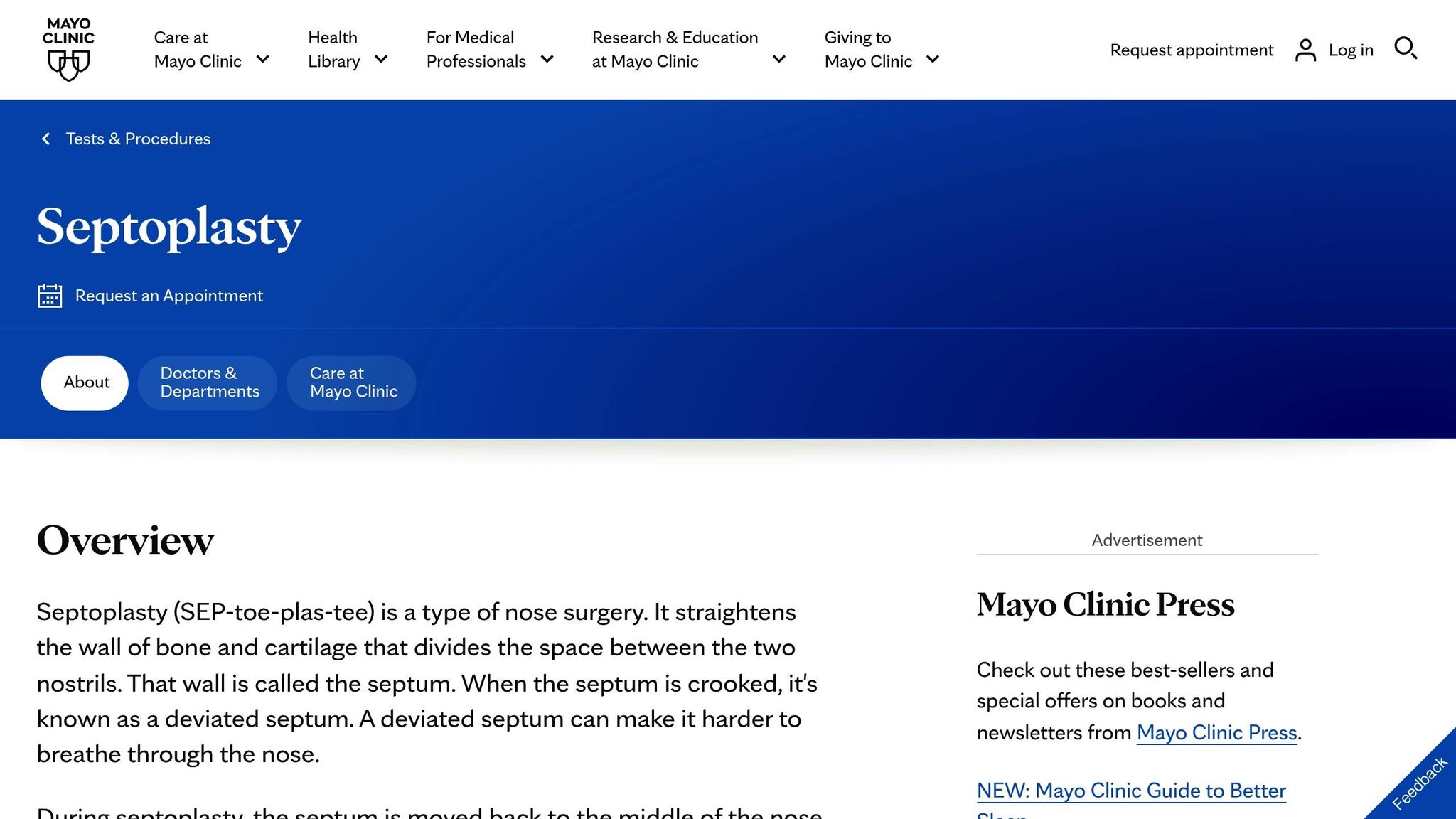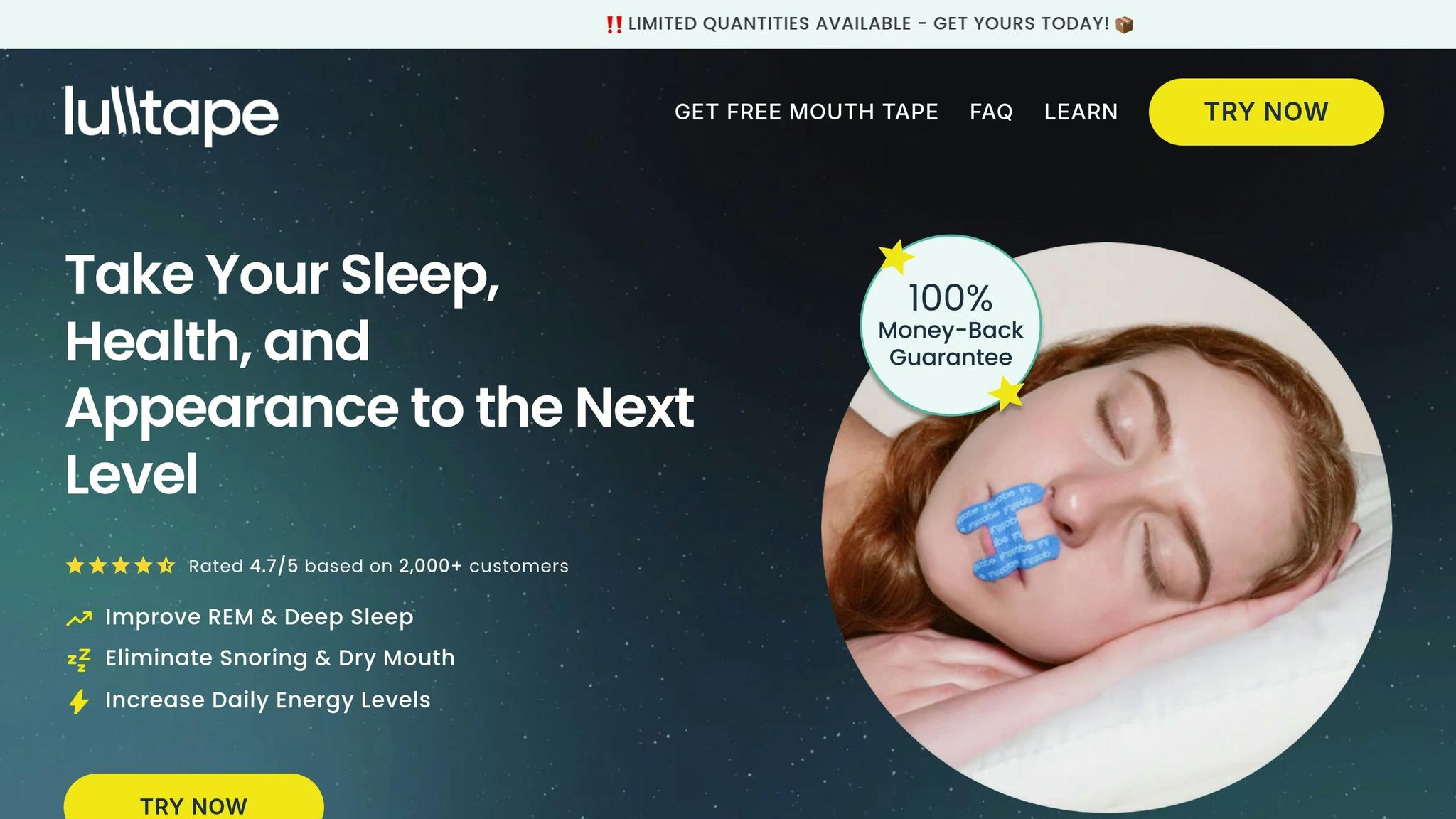Struggling to breathe through your nose? Surgery may be the solution. Nasal obstruction, often caused by a deviated septum, can lead to poor sleep, mouth breathing, and chronic fatigue. While non-surgical treatments like nasal strips or mouth tape can help temporarily, they don’t fix structural issues. Surgery, such as septoplasty, aims to restore proper airflow and improve sleep quality.
Key Takeaways:
- Symptoms: Blocked nasal passages, snoring, sinus infections, and frequent nosebleeds.
- Non-Surgical Options: Provide short-term relief but don’t address the root cause.
- Surgical Treatments: Septoplasty, turbinate reduction, or combined procedures like septorhinoplasty.
- Post-Surgery Benefits: Easier breathing, better sleep, more energy, and improved overall health.
If nasal obstruction disrupts your life, consult a specialist to explore surgical options and long-term solutions.
Signs Surgery is Needed
Medical Reasons for Surgery
A severely deviated septum can block airflow, leading to constant nasal congestion and mouth breathing. These issues often signal the need for surgical intervention. Persistent symptoms like nasal blockage, chronic mouth breathing, and snoring are red flags for a structural problem that surgery is best equipped to fix.
Why Other Treatments May Not Work
Non-surgical options might ease symptoms temporarily, but they don’t address the root cause. For example, nasal strips can provide short-term relief but won’t correct the structural obstruction. When these methods fall short, a surgical evaluation becomes necessary. Tools like CT scans and nasal endoscopy help doctors determine the severity of the deviation.
Products like lulltape mouth tape can encourage nasal breathing during sleep, but they’re meant to support - not replace - surgical treatment when it’s needed. These are complementary aids, not standalone solutions for structural issues.
Types of Surgery Available
Septoplasty Procedure

Septoplasty is the main surgical option for fixing a deviated septum. The goal is to reposition the septum to improve nasal airflow and breathing.
In some cases, septoplasty alone may not address all issues, and additional procedures might be required.
Other Surgical Options
When a deviated septum is accompanied by other structural problems, surgeons may recommend combining procedures such as:
- Turbinate Reduction: Shrinks enlarged turbinates to create more space for airflow.
- Septorhinoplasty: Corrects the septum while also reshaping the nose.
- Endoscopic Sinus Surgery: A minimally invasive method used when sinus blockages are present along with a deviated septum.
Results After Surgery
Improved Breathing and Sleep
After surgery, patients often experience easier breathing, better oxygen intake, and more restful sleep.
- Better Oxygen Flow: Cleared nasal passages help filter, warm, and humidify air, which supports lung function.
- Less Snoring, Better Sleep: With reduced airflow resistance, nasal passages help maintain steady oxygen levels throughout the night.
Using tools like nasal strips or other aids during sleep can increase oxygen intake by up to 20%. These changes lead to noticeable health improvements.
Positive Health Changes
Improved nasal breathing supports better oxygen delivery and nitric oxide intake, both of which are key for muscle function and reducing fatigue. It also encourages proper tongue positioning and facial muscle engagement.
| Health Area | Post-Surgery Benefits |
|---|---|
| Energy Levels | More daytime alertness |
| Fitness | Better exercise performance |
| Stress Control | Improved nervous system balance |
| Oral Health | Less dry mouth, fewer dental issues |
To keep these benefits long-term, it's important to maintain good nasal breathing habits, especially during sleep. Surgery combined with proper breathing techniques can lead to lasting improvements in overall health and respiratory function.
sbb-itb-31084ec
Sight + Sound Bites: Nasal Obstruction: The Deviated Septum ...
Supporting Tools for Nasal Breathing
After surgery improves airflow, maintaining proper breathing habits is key for lasting results.
lulltape: Sleep Breathing Support

Post-surgery, tools like lulltape can help improve breathing patterns. Designed with an H-shaped form and made from hypoallergenic materials, lulltape ensures comfort while encouraging nasal breathing. Research suggests this method can increase oxygen intake by up to 20% during sleep.
| Benefit | Role in Post-Surgery Recovery |
|---|---|
| Oxygen Flow | Promotes better oxygen delivery through the nose |
| Moisture Retention | Helps maintain moisture and supports oral health |
| Breathing Habits | Reinforces nasal breathing routines |
| Comfort | Noninvasive design allows natural movement |
Users have shared positive experiences. Robert J. says, "The improvement in my sleep quality was almost immediate. Love lulltape!" Similarly, Sarah D. notes, "lulltape has drastically improved my sleep quality. A must-have!".
For best results, apply one strip of lulltape over your mouth before bed each night. Combining surgical treatment with breathing support tools like lulltape creates a well-rounded approach to managing nasal obstruction. With a 4.7/5 rating from over 2,000 reviews, lulltape is a trusted addition to your recovery plan.
Next Steps
After surgery, the focus shifts to maintaining and building on your improved breathing.
Choosing Your Treatment
Deciding on nasal surgery starts with consulting a specialist. Keep a record of your symptoms to show how nasal obstruction affects your daily life. Once you’ve chosen a treatment plan, concentrate on recovery tools that support healthy nasal breathing.
Additional Care Options
To ensure lasting results, it’s important to develop consistent nasal breathing habits. Post-treatment care plays a key role in maintaining improved airflow and supporting long-term respiratory health. Tools like lulltape can be helpful in this process, especially during sleep.
Here’s what lulltape offers:
| Recovery Support Element | Benefit |
|---|---|
| Cost | $19.99 with a 30-day money-back guarantee |
| Comfort | Designed to be non-restrictive and comfortable for sleep |
"lulltape has totally transformed my sleep, can't recommend it enough." - Brandon W., Verified Customer
Incorporating tools like lulltape into your routine can help you maintain proper breathing patterns. Combining professional medical care with consistent attention to your breathing - both during sleep and throughout the day - can greatly support your recovery process.



